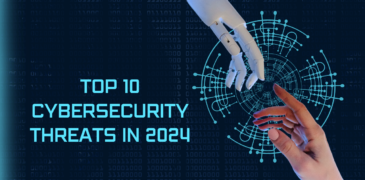In the world of Technology, the year 2024 unveils a excess of challenges in the cybersecurity domain. As our digital world becomes more intricately connected, ensuring the protection of sensitive information takes center stage. This article delves into the imminent top 10 cybersecurity threats, dissecting the intricate tactics employed by cybercriminals and shedding light on vulnerabilities faced by both organizations and individuals. From sophisticated advanced persistent threats to emerging risks within the swiftly expanding realms of IoT and cloud computing, comprehending these threats is imperative for bolstering defenses against the ever-changing nature of cyber attacks.
Advanced Persistent Threats (APTs)
Advanced Persistent Threats (APTs) represent a formidable class of cyber threats characterized by their persistence, sophistication, and strategic nature. These stealthy, long-term attacks are orchestrated by highly skilled threat actors, often with the backing of nation-states or advanced criminal organizations. APTs aim to infiltrate and remain undetected within target systems, enabling unauthorized access to sensitive information, espionage, or the disruption of critical infrastructure. Employing advanced tactics, such as zero-day exploits and social engineering, APTs continuously evolve to bypass traditional security measures. Mitigating the risk of APTs requires robust cybersecurity strategies, constant vigilance, and proactive threat intelligence.
Ransomware Resurgence
The resurgence of ransomware stands as a grave cybersecurity concern in 2024, signaling an alarming evolution in the tactics and impact of malicious actors. This breed of cyber threat has transitioned from mere financial extortion to a strategic weapon capable of disrupting critical infrastructure, governmental operations, and corporate entities worldwide. Sophisticated ransomware variants employ encryption algorithms, rendering data inaccessible until a ransom is paid, often in cryptocurrencies, exacerbating the difficulty of tracing the perpetrators. Targets range from large corporations to essential service providers, amplifying the potential socio-economic fallout.
The rise of double and triple extortion tactics further compounds the threat, where attackers not only encrypt data but also threaten to leak sensitive information unless additional demands are met.
Zero-Day Exploits
Zero-Day Exploits represent a critical cybersecurity challenge in 2024, embodying the stealth and potency of advanced cyber threats. These exploits target undisclosed vulnerabilities in software, hardware, or operating systems, exploiting security gaps before developers can release patches, hence the term “zero-day” — denoting the absence of defense. Cyber adversaries leverage these vulnerabilities to gain unauthorized access, execute malicious code, and compromise systems, often with the goal of exfiltrating sensitive data or facilitating broader cyber attacks.
The increased commodification of zero-day exploits on the dark web exacerbates the threat landscape, enabling both state-sponsored actors and cybercriminals to acquire and deploy these potent tools. Mitigating the risk posed by zero-days demands proactive security measures, including robust vulnerability management, threat intelligence integration, and rapid response protocols to address and neutralize emerging threats before they can be weaponized against organizations and individuals.
Supply Chain Attacks
Supply Chain Attacks emerge as a pervasive and intricate cybersecurity threat in 2024, revealing the vulnerability inherent in interconnected digital ecosystems. In these attacks, malicious actors exploit weaknesses within the supply chain to compromise software or hardware, often with the intent of infiltrating target organizations indirectly. By compromising a trusted supplier or service provider, cybercriminals can compromise the integrity of the entire supply chain, leading to potential data breaches, unauthorized access, or the insertion of malicious code into widely distributed products.
The far-reaching consequences of supply chain attacks extend beyond individual organizations, impacting end-users and potentially causing cascading disruptions across sectors. Organizations must adopt stringent measures, including thorough vetting of suppliers, continuous monitoring, and robust cybersecurity protocols, to safeguard against these sophisticated attacks and ensure the resilience of the interconnected digital landscape.
Cloud Security Challenges
Cloud Security Challenges emerge as a critical focal point in the cybersecurity landscape of 2024, mirroring the rapid adoption of cloud services across industries. As organizations transition to cloud infrastructures, they grapple with a myriad of security considerations, including misconfigurations, insecure interfaces, and data breaches. The dynamic nature of cloud environments and the shared responsibility model between cloud service providers and users add layers of complexity, demanding robust security measures.
Instances of data exposure, unauthorized access, and insecure application programming interfaces (APIs) underscore the need for enhanced cloud security postures. Organizations must implement comprehensive security policies, conduct regular audits, and leverage advanced technologies such as cloud security posture management (CSPM) tools to ensure the confidentiality, integrity, and availability of data in the cloud.
Internet of Things (IoT) Vulnerabilities
Internet of Things (IoT) Vulnerabilities pose a significant and growing threat in 2024, as the proliferation of interconnected devices continues to outpace robust security measures. The expanding IoT landscape introduces an array of potential vulnerabilities, as these devices often operate with limited resources and diverse architectures. Insecure IoT devices become attractive targets for cybercriminals aiming to exploit weak security protocols, gain unauthorized access, or launch large-scale distributed denial-of-service (DDoS) attacks.
The potential consequences of compromised IoT devices extend beyond individual privacy breaches, encompassing broader security risks to critical infrastructure and interconnected networks. As IoT adoption accelerates across industries, addressing these vulnerabilities requires a concerted effort involving manufacturers, developers, and regulatory bodies.
Deepfake and AI Manipulation
Deepfake and AI Manipulation represent a pressing cybersecurity concern in 2024, as artificial intelligence (AI) advancements enable the creation of increasingly convincing manipulated content. Deepfakes, which involve AI-driven synthesis of realistic audio, video, or text, raise profound challenges in discerning truth from falsity. Malicious actors exploit this technology to create deceptive content, fueling misinformation campaigns, damaging reputations, and undermining the trust in digital media.
The implications extend to various sectors, including politics, business, and personal relationships, necessitating robust detection mechanisms and countermeasures. As AI-driven manipulation techniques evolve, the need for advanced authentication tools, media forensics, and ethical AI frameworks becomes imperative.
Phishing 2.0
Phishing 2.0 emerges as a sophisticated evolution of cyber threats in 2024, transcending traditional phishing methods to become more targeted, personalized, and elusive. This advanced form of social engineering leverages intricate tactics, such as spear-phishing and vishing, to exploit human vulnerabilities and gain unauthorized access to sensitive information. Cybercriminals employ highly tailored approaches, often using deceptive emails, messages, or voice communications that convincingly mimic trusted sources, making detection challenging.
Phishing 2.0 capitalizes on psychological manipulation, leveraging insights from social media and other sources to craft convincing lures. As individuals and organizations fortify against conventional phishing, the threat landscape evolves, demanding enhanced user awareness, multi-layered security measures, and adaptive cybersecurity strategies.
Cryptocurrency-Related Threats
Cryptocurrency-Related Threats emerge as a prominent concern in the cybersecurity landscape of 2024, reflecting the pervasive adoption of digital currencies and blockchain technologies. As the use of cryptocurrencies increases, cybercriminals actively exploit vulnerabilities within this decentralized ecosystem. Threats encompass a spectrum, including attacks on cryptocurrency exchanges, fraud in Initial Coin Offerings (ICOs), and the targeting of digital wallets. The anonymity associated with cryptocurrencies complicates investigations, amplifying the risks of financial crimes and extortion.
Additionally, the rise of crypto-mining malware and ransomware demanding payments in cryptocurrencies heightens the security challenges. Mitigating these threats requires a multi-faceted approach, involving secure practices in cryptocurrency transactions, regulatory frameworks, and collaboration between the cybersecurity community and the cryptocurrency industry.
Nation-State Cyber Operations
Nation-State Cyber Operations stand at the forefront of cybersecurity concerns in 2024, marking an era where governments leverage sophisticated cyber capabilities for political, economic, and military objectives. State-sponsored cyber attacks, orchestrated by nation-states with substantial resources and strategic intent, pose a formidable threat to global security. These operations encompass a range of activities, from espionage and information warfare to the disruption of critical infrastructure.
The advanced techniques and persistent nature of nation-state cyber operations require a paradigm shift in cybersecurity strategies. Nations must fortify their cyber defenses, invest in threat intelligence, and engage in international cooperation to deter and respond effectively to these orchestrated attacks.
Conclusion
From the stealthy persistence of Advanced Persistent Threats (APTs) to the resurgence of ransomware and the sophisticated manipulations of AI-driven deepfakes, organizations face a multifaceted challenge. Supply chain vulnerabilities, cloud security complexities, and the persistent specter of nation-state cyber operations add layers of urgency. As we navigate these cyber threats, proactive measures, collaborative efforts, and technological advancements become imperative to fortify defenses.
Also Read:







